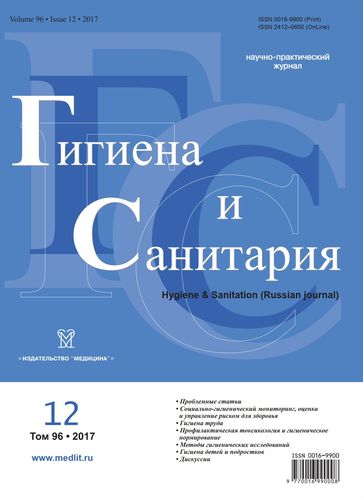Chemical-analytical studies for the evaluation of the chemical safety of substances migring in water environments with waste of oil-exchanging industry
- Авторлар: Malysheva A.G.1, Samutin N.M.1, Kozlova N.Y.1, Butorina N.N.1, Yudin S.M.1, Rastyannikov E.G.1
-
Мекемелер:
- Centre for Strategic Planning and Management of Biomedical Health Risks
- Шығарылым: Том 96, № 12 (2017)
- Беттер: 1208-1215
- Бөлім: METHODS OF HYGIENIC AND EXPERIMENTAL INVESTIGATIONS
- ##submission.datePublished##: 21.10.2020
- URL: https://rjraap.com/0016-9900/article/view/640755
- DOI: https://doi.org/10.47470/0016-9900-2017-96-12-1208-1215
- ID: 640755
Дәйексөз келтіру
Толық мәтін
Аннотация
The oil industry, transporting industry and processing industry is the most hazardous branches of the national economy as an increase of their production inevitably leads to an increase in volumes of petroleum pollution and waste. This is accompanied by an increase in environmental threats, a decrease in the area of economic lands, a decrease of soil fertility and a degradation of human health. The large-scale exploitation of subsoil and the increase in volumes of oil refining contributes to the increased risk of an environmental pollution, beginning from the stage of oil exploration and production and ending with the use of oil products. The pollution of environment takes place with the implementation of drilling processes and preparation of wells for operation. The drilling processes are accompanied by dispersed rock destruction, the formation of drill cuttings and removing it with washing liquid. The formation of significant quantities of oily wastes decreases the economic efficiency of enterprises in oil and gas industry due to the need of alienation of the territory of those enterprises for the oily waste storages, the increase of environmental payments for waste storage and pollutant emissions. According to Federal law “On production and consumption wastes”, every enterprise must develop “passports of hazardous waste”. The study of the chemical composition of a wide range of organic substances, metals and elements migrating to aquatic environments by modern highly sensitive methods of physical and chemical analysis provides the possibility to identify early unknown and unaccounted matters in oily wastes, which are capable of entering environmental water bodies. There were identified up to 100 organic compounds among substances that migrate to aquatic environments. The spectrum of detected organic substances is presented by aromatic, polycyclic aromatic, naphthenoaromatic hydrocarbons, biphenyls and oxygen-containing compounds, including alcohols, phenols, aldehydes, ketones, complex ethers, furans, quinones and nitrogen- and sulfur-containing compounds. The analysis of the inorganic component of oily wastes that migrate to aquatic environments showed that among 70 metals and elements studied the largest mass fraction was in alkaline-earth metals (< 82%) and alkali metals (< 33%). There was established the presence of sulfur (< 1%), iron (< 0,25%) and heavy metals: copper and tin (0.002% in total). The studies of the anion composition of oily wastes’ water extracts established the presence of chlorine, carbonate and bicarbonate ions. The concentration of sulfate ion was below the method’s sensitivity level.
Негізгі сөздер
Авторлар туралы
Alla Malysheva
Centre for Strategic Planning and Management of Biomedical Health Risks
Хат алмасуға жауапты Автор.
Email: fizhim@yandex.ru
MD, PhD, DSci., professor, head of the Laboratory of physical and chemical research of the Centre for Strategic Planning and Management of Biomedical Health Risks, Moscow, 119121, Russian Federation.
e-mail: fizhim@yandex.ru
РесейN. Samutin
Centre for Strategic Planning and Management of Biomedical Health Risks
Email: noemail@neicon.ru
Ресей
N. Kozlova
Centre for Strategic Planning and Management of Biomedical Health Risks
Email: noemail@neicon.ru
Ресей
N. Butorina
Centre for Strategic Planning and Management of Biomedical Health Risks
Email: noemail@neicon.ru
Ресей
S. Yudin
Centre for Strategic Planning and Management of Biomedical Health Risks
Email: noemail@neicon.ru
Ресей
E. Rastyannikov
Centre for Strategic Planning and Management of Biomedical Health Risks
Email: noemail@neicon.ru
Ресей
Әдебиет тізімі
- Izteleuova M.B. Modern problems of oil ecology. Neft’ i gaz. 2002; (1): 48-51. (in Russian)
- Glazovskaya M.A. Soil-geochemical mapping for environmental sustainability assessment. Pochvovedenie. 1992; (6): 5-14. (in Russian)
- Urazbekov A.K., Bektenov M.B., Akbasova A.D. Physico-chemical properties of waste oil in railway transport. Vestnik NII razvitiya putey soobshcheniya. 2007; (4): 42-6. (in Russian)
- Khayrov G.B. Modern environmental problems in the oil industry of the Republic of Kazakhstan. Neft’ i gaz. 2001; (3): 93-8. (in Russian)
- Kireev M.A., Nadirov N.K. Ecological problems in the oil industry of Kazakhstan and ways to solve them. Neft’ i gaz. 1998; (4): 130-7. (in Russian)
- Bashirov V.V., Bril’ D.M., Ferdman V.M. Technique and Technology of Phased Disposal and Processing of Granulated Sludge [Tekhnika i tekhnologiya poetapnogo udaleniya i pererabotki ambarnykh shlamov]. Moscow; 1992. (in Russian)
- Ruchnikova O.I. Ecological technologies: review of the main directions of using oil waste as a secondary raw material. Inzhenernaya ekologiya. 2004; (1): 2-15 (in Russian)
- Bondaletova L.I., Bondaletov V.G. Industrial Ecology [Promyshlennaya ekologiya]. Moscow: ASV; 2008. (in Russian)
- Malysheva A.G., Rastyannikov E.G., Bezzubov A.A., Kozlova N.Yu., Baeva I.V., Abramov E.G. Analytical studies in assessing the safety and efficacy of new technologies in environmental medicine. Gigiena i sanitariya. 2006; 85(1): 32-4. (in Russian)
- Malysheva A.G., Rakhmanin Yu.A., Rastyannikov E.G., Kozlova N.Yu., Artyushina I.Yu., Shokhin V.A. Chromato-mass-spectrometric study of volatile emissions of plants for assessing the efficacy and chemical safety of the use of environment-improving phytotechnologies. Gigiena i sanitariya. 2016; 95(6): 501-7. (in Russian)
- Malysheva A.G. Laws of transformation of organic compounds in the environment. Gigiena i sanitariya. 1997; 76(3): 5-10. (in Russian)
- Malysheva A.G., Rakhmanin Yu.A. The Physical and Chemical Studies and Methods of Substances Control in the Environmental Hygiene [Fiziko-khimicheskie issledovaniya i metody kontrolya veshchestv v gigiene okruzhayushchey sredy]. St. Petersburg: Professional; 2012. (in Russian)
Қосымша файлдар







